The invention of the telescope - Dionysis P. Simopoulos September 15, 2020 – Posted in: Magazine – Tags: editorial, space, Dionysis P. Simopoulos, science, magazine, technology

Introductory note of Dionysis P. Simopoulou, Honorary director Eugenidei Planetariou for the #5 issue of the magazine How it works
The wide variety of science and technology articles included in each issue of our magazine each time gives its readers the opportunity to choose the order in which they read them, depending on their interests. The same thing happens to me every time. So, as I flipped through today's issue, the article that grabbed my immediate interest was obviously the one that refers to telescopes, those instruments that, since their discovery until today, have revealed to us the secrets of the universe. And although Galileo was not the one who invented the telescope, he was undoubtedly the first to appreciate its importance and the importance of the observations he made with it in the early 17th century.
It is, however, quite surprising that the invention of the telescope took so long, since the magnifying power of certain convex and hollow transparent objects was known from ancient times. Even glass making was known in Egypt as early as 3500 BC, while some rudimentary lenses have been found in excavations in Crete dating back to 2000 BC. Nevertheless, lenses in the form we know them today were presented in Europe only in the 13th century, when the appropriate processing techniques were created in the glass workshops of Venice and Florence.
As far back as Roger Bacon (c. 1220-1292), magnifying lenses had been used to help people with presbyopia read. However, these lenses did not help easily in writing either. So Venetian glassmakers made smaller biconvex lenses, which they placed in a frame that could rest on the wearer's nose and ears. In this way the glasses of presbyopia (around 1350) and later (around 1450) of myopia were first created using concave lenses. Thus, by the middle of the 15th century all the materials with which the first telescopes could have been made were at the disposal of the opticians of the day, since a simple telescope is nothing more than the appropriate combination of concave and convex lenses and mirrors. Nevertheless, the invention of the telescope was not immediately achieved.

Many today claim that the first telescope, a simple combination of a convex lens and a mirror, was built in England in 1570 by John Dee (1527-1608) and Leonard and Thomas Digges (c. 1515-c. 1559). , and Thomas Digges, 1546-1595). Nevertheless, this honor is now given to the Dutchman Hans Lippershey (c. 1570-c. 1619), who officially presented his invention in October 1608. This first telescope consisted of a combination of a biconvex and of a biconcave lens, placed inside a metal tube, and could magnify distant objects three times (3X).
Dozens of such instruments were made and sold in Italy, Germany and France in the following year, with which anyone could see distant objects appear closer. As it can be seen, such an instrument with a power of 6X was used by Thomas Harriot (Thomas Harriot, 1560-1621), who made the first observations of the surface of the Moon in August 1609 with his optical tube, as the telescope was originally called. The name "telescope" was proposed for the first time in 1612 by the Greek mathematician Ioannis Dimiziani, who was the secretary of an Italian cardinal, although it was not established until several decades later.

But the one who gave the telescope its great fame was the Italian mathematician and astronomer Galileo Galilei (Galileo Galilei, 1564-1642). Galileo built his first telescope of 3X power in June 1609, a second of 8X power two months later, and a third of 20X power in October of the same year. With the help of these small telescopes, Galileo discovered the 4 largest moons of Jupiter, scientifically confirming the fact that the Earth is not the center of the Universe, while simultaneously opening the age of technology and the scientific revolution. He then discovered and plotted the various lunar features and separated them into mountains, craters and "seas", and later (in 1611) saw the phases of Venus and the sun's photosphere its dark spots.
When Galileo turned his telescope to the band of the Milky Way, thousands of new stars that were invisible to the naked eye stood out before his eyes. He thus correctly realized that the real reason stars seem to remain in fixed constellation formations is because, compared to the planets, the stars are at enormous distances from us. However, the ecclesiastical establishment of the time could not tolerate the new discoveries. Because of this, Galileo was persecuted and with the threat of torture forced to renounce his ideas and spend the rest of his life imprisoned in his home, until he died in 1642 at the age of 78. But the new ideas spread everywhere like wildfire. And in the end even the Church understood that neither excommunications, nor burning books, nor threats, nor executions could stop the spread of new knowledge.
